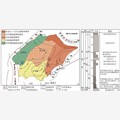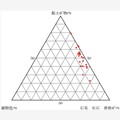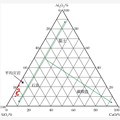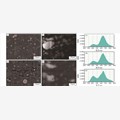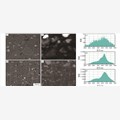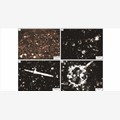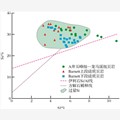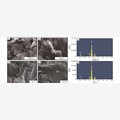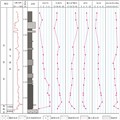引用本文
Zhao Jianhua,Jin Zhijun,Jin Zhenkui,et al.The genesis of quartz in Wufeng-Longmaxi gas shales,Sichuan Basin[J].Natural Gas Geoscience,2016,27(2):377-386.[赵建华,金之钧,金振奎,等.四川盆地五峰组—龙马溪组含气页岩中石英成因研究[J].天然气地球科学,2016,27(2):377-386.]

doi:10.11764/j.issn.1672-1926.2016.02.0377
四川盆地五峰组—龙马溪组含气页岩中石英成因研究
中图分类号:TE122.2 文献标志码:A 文章编号:1672-1926(2016)02-0377-10
The genesis of quartz in Wufeng-Longmaxi gas shales,Sichuan Basin
Key words: Genesis of quartz; Reservoir quality; Detrital quartz; Biogenic quartz;
引言
随着页岩岩石学特征研究的不断深入,发现黏土矿物并不是页岩储层的主要矿物类型,而是以石英、长石及碳酸盐矿物及其混合为主导,特别是石英的含量通常超过30%[1-4]。石英的来源除了陆源的供给外,在成岩过程中形成的石英也是页岩储层重要的组成部分,泥(页)岩中石英的成因(特别是成岩过程中形成的石英)研究是一项长期以来的难题[5-7]。Schieber等[8]对美国东部泥盆系页岩研究发现页岩中几乎全部的粉砂都是在成岩过程中形成,与硅质生物骨骼的溶解和再沉淀有关,同样在Barnett页岩、Woodford页岩和Marcellus 页岩中也发现了同样的特征[1-9,10]。在成岩演化过程中,蒙脱石向伊利石转化会释放出硅质,形成颗粒状或者板片状的石英胶结物[11-13]。石英是影响页岩可压裂性和诱导裂缝形态的重要因素,其含量越高,页岩可压裂性越好。明确页岩储层中石英的成因,对于页岩沉积环境分析以及有利储层的分布预测都具有重要意义。 页岩气是当今油气勘探的前沿领域,也是石油地质研究的热点。近年来,中国页岩气的勘探和开发已取得了实质性的进展。四川盆地作为页岩气勘探开发的主战场,上奥陶统五峰组—下志留统龙马溪组富有机质页岩是关键的勘探目标[14-16]。四川盆地五峰组—龙马溪组页岩石英含量为15.6%~55%,平均值为36%,石英含量与Barnett页岩类似,而对于这套富有机质页岩中石英的成因相关研究较少,本文通过野外露头和岩心薄片观察、扫描电镜及地球化学测试数据分析,探讨四川盆地五峰组—龙马溪组下段页岩中石英的成因、分布规律及其对页岩储层质量的影响,进而为四川盆地有利页岩储层的分布预测提供理论依据。
1 研究区概况
四川盆地位于四川省东部及重庆市,西抵龙门山,东至齐耀山,北至米苍山—大巴山,南至大凉山—娄山。以现今残存陆相地层边界为界,盆地面积为18×104km2,是一个在上扬子克拉通基础上发展起来的叠合盆地[17]。以华蓥山和龙泉山2个背斜带为界,将四川盆地划分为3个构造单元(图1):华蓥山断裂带以东的川东南斜坡高陡构造区(包括川东高陡褶皱带和川南低陡褶皱带)、龙泉山以西的川西凹陷低陡构造区和介于华蓥山与龙泉山之间的川中隆起低缓构造区[18]。四川盆地所在的上扬子地块受到多期构造运动的影响,在不同时期发育了多种盆地原型。在晚奥陶世,边缘古隆起已形成,特别是雪峰隆起、川中隆起和黔中隆起出露海平面之上,使早中奥陶世具有广海特征的海域转变为被隆起所围限的局限浅海域,形成大面积低能、欠补偿、缺氧的沉积环境[19]。受构造运动及海侵影响,晚奥陶世五峰期沉积了一套稳定的笔石相薄层黑色页岩,主要为硅质页岩、硅质岩,分布范围广泛,厚度仅数米、个别地区达数十米[20]。五峰组顶部通常为一套富含介壳泥灰岩、灰质泥岩,厚度几十厘米,称为观音桥段。早志留世龙马溪期,在扬子克拉通上,构造—古地理表现为形成古隆起的高峰阶段,隆起边缘主要发育潮坪、潟湖相、向中部为局限浅海陆架[19],岩性以灰至灰黑色泥页岩占绝对优势,局部夹粉细砂岩;厚度分布介于55~516m之间(图1)。
2 石英成因类型
A井五峰组—龙马溪组22个页岩样品XRD分析结果表明,石英含量介于15.6%~55.2%之间,平均值为36%(图2);A井14个页岩样品主量元素分析表明,SiO2含量介于43.34%~73.80%之间,平均值为62.8%;Al2O3含量介于3.5%~15.7%之间,平均值为14.0%;CaO含量介于0.51%~18.01%之间,平均值为2.34%。主量元素三元图表明,该套页岩SiO2含量均高于页岩平均值[22,23],相对于Al2O3而言更富集SiO2(图3)。 泥质沉积物中石英的来源除了陆源的供给外,在成岩过程中形成的石英也是页岩储层重要的组成部分。区分陆源碎屑石英和成岩过程中形成的石英主要依靠扫描电镜、阴极发光—扫描电镜以及硅、氧同位素分析等手段,通过分析矿物的形态及发光强度来判断。通过普通薄片观察,扫描电镜结合阴极发光以及主量元素分析,在五峰组和龙马溪组页岩中识别出陆源石英和成岩过程中形成的石英,成岩过程中形成的石英又可进一步划分出生物成因的石英和黏土矿物转化过程中形成的石英。
图2 五峰组—龙马溪组页岩矿物组成三角图
Fig.2 Mineralogy triangle diagrams of Wufeng-Longmaxi Formations shales
2.1 陆源石英
泥岩中陆源碎屑成分是母岩物理和化学风化的产物,以及少部分火山灰和陆源的有机物质[24-26]。石英作为陆源碎屑中分布最广的一种矿物成分,抗风化能力很强,既抗磨又难分解,通过河流、冰川或者风搬运到盆地中[27]。研究区陆源搬运的石英颗粒直径较大,介于10~20μm之间,呈次圆状—次棱角状,个别呈棱角状,边缘模糊。陆源碎屑石英在SEM-CL图像上表现为强发光,单色阴极发光光谱一般有2个峰值,其中主峰出现在620~650nm处,次峰出现在420~450nm处(图4)。Peltonen等[7]在研究挪威海域下白垩统—新近系页岩地层时发现,其中的碎屑石英棱角鲜明,阴极发光谱图同样有2个峰值,与本文陆源碎屑石英具有相似的特征。
2.2 成岩过程中形成的石英
2.2.1 生物成因石英
该类型石英通常以隐晶、微晶及微晶聚集体的形式出现,呈不规则状,大小介于3~10μm之间。阴极发光照射下呈弱发光—不发光[图5(a),图5(e)],这是与陆源石英最主要的区别。阴极发光光谱为钟形,峰值出现在波长620~650nm之间,另外有些石英在波长370~420nm处出现次峰,在370nm附近次峰明显[图5(c),图5(f),图5(g)],在420nm附近次峰不明显[图5(c),图5(g)]。
图3 五峰组—龙马溪组页岩SiO2—Al2O3—CaO含量三角图
Fig.3 Ternary diagram showing relative proportions of SiO2,Al2O3 and CaO in Wufeng-Longmaxi Formations shales
图4 五峰组—龙马溪组页岩中陆源石英特征
Fig.4 Characteristics of detrital quartz in Wufeng-Longmaxi Formations shales
图5 五峰组—龙马溪组页岩中生物成因石英
Fig.5 Biogenic silica in Wufeng-Longmaxi Formations shales
2.2.2 黏土矿物转化过程中形成的石英
该类型石英呈微米级颗粒,嵌入在黏土基质中,大小介于1~3μm之间,晶体呈短链状、小晶簇状聚
图6 五峰组—龙马溪组页岩中硅质生物化石
Fig.6 Siliceous organism fossils in Wufeng-Longmaxi Formations shales
(a)大量放射虫化石,部分被硅质充填,冷水溪剖面,S1ln;(b)放射虫化石,部分被硅质充填,B井,O3ln;(c)硅质海绵骨针,A井,S1ln;(d)放射虫化石,A井,S1ln
图7 五峰组—龙马溪组页岩及Barnett页岩Si—Al含量相关(Barnett页岩数据来自文献[30])
Fig.7 Corss-plots of Si and Al of Wufeng-Longmaxi Formations shales(Barnett shale data from Ref.[30])
Table 1 The main elements data of Wufeng-Longmaxi Formations shales in well A
| 样品号 | 元素含量/% | Si/Al | Al/(Fe+ Al+Mn) | ||||||||||
| SiO2 | Al2O3 | Na2O | MgO | P2O5 | K2O | CaO | TiO2 | MnO | Fe2O3 | TOC | |||
| A-1 | 62.86 | 16.71 | 0.74 | 2.56 | 0.07 | 4.17 | 0.35 | 0.67 | 0.04 | 6.26 | 0.54 | 3.31 | 0.67 |
| A-2 | 61.84 | 17.42 | 0.76 | 2.48 | 0.07 | 4.37 | 0.22 | 0.65 | 0.03 | 5.76 | 1.46 | 3.13 | 0.69 |
| A-3 | 57.52 | 20.38 | 0.65 | 2.69 | 0.07 | 5.28 | 0.19 | 0.79 | 0.03 | 6.54 | 0.52 | 2.49 | 0.70 |
| A-4 | 70.85 | 12.07 | 0.72 | 1.79 | 0.07 | 3.00 | 1.81 | 0.45 | 0.02 | 3.38 | 1.55 | 5.17 | 0.73 |
| A-5 | 64.28 | 14.24 | 0.78 | 2.16 | 0.09 | 3.54 | 2.06 | 0.57 | 0.03 | 4.96 | 1.84 | 3.98 | 0.68 |
| A-6 | 63.51 | 12.38 | 1.05 | 1.98 | 0.10 | 3.11 | 2.87 | 0.62 | 0.03 | 6.85 | 1.73 | 4.53 | 0.58 |
| A-7 | 68.25 | 11.28 | 0.95 | 1.62 | 0.09 | 2.94 | 2.08 | 0.57 | 0.02 | 5.08 | 2.13 | 5.34 | 0.63 |
| A-8 | 64.55 | 12.36 | 1.09 | 1.82 | 0.09 | 3.19 | 2.67 | 0.66 | 0.03 | 5.30 | 2.46 | 4.61 | 0.64 |
| A-9 | 68.68 | 10.51 | 0.64 | 1.48 | 0.08 | 2.93 | 1.91 | 0.49 | 0.02 | 4.20 | 3.81 | 5.75 | 0.65 |
| A-10 | 68.55 | 9.62 | 0.97 | 1.21 | 0.08 | 2.65 | 3.92 | 0.53 | 0.02 | 3.14 | 3.35 | 6.28 | 0.70 |
| A-11 | 69.49 | 9.53 | 0.76 | 1.37 | 0.08 | 2.64 | 3.17 | 0.50 | 0.02 | 3.33 | 3.87 | 6.43 | 0.68 |
| A-12 | 72.61 | 8.53 | 0.85 | 1.06 | 0.10 | 2.20 | 2.45 | 0.44 | 0.02 | 2.37 | 4.23 | 7.51 | 0.73 |
| A-13 | 64.66 | 11.56 | 0.68 | 1.35 | 0.10 | 2.89 | 1.77 | 0.92 | 0.02 | 5.62 | 4.14 | 4.93 | 0.61 |
| A-14 | 68.19 | 14.54 | 0.80 | 1.99 | 0.07 | 3.68 | 1.20 | 0.74 | 0.02 | 3.41 | 0.3 | 4.13 | 0.76 |
图8 五峰组—龙马溪组页中黏土矿物转化形成的石英
Fig.8 Quartz crystals sourced from the smectite to illite reaction in Wufeng-Longmaxi Formations shales
2.3 垂向分布规律
A井五峰组—龙马溪组下段全岩XRD分析数据,表明石英含量由下至上逐渐降低(图9),薄片上硅质生物化石也相应减少,陆源石英逐渐增多,表明提供生物成因石英生物体逐渐减少。生物成因的石英主要分布在五峰组和龙马溪组下部页岩中,而黏土矿物转化过程中形成的微晶石英在各个样品中均可见到。海洋沉积物由陆源碎屑和海洋自生组分组成,Al与陆源碎屑有关,在细粒沉积物中主要保存在黏土矿物中[39],Si在陆源碎屑和生物组分中均可存在,来自陆源的粉砂可增加石英含量,使Si/Al值上升,但是五峰组—龙马溪组页岩反映陆源粗碎屑注入的指标TiO2和Ti/Al值相对稳定,表明陆源粗碎屑供应相对稳定,因此生物成因的石英是导致Si/Al值升高的主要因素。A井五峰组—龙马溪组页岩由下至上Si/Al值逐渐减少,表明陆源黏土矿物逐渐增多,同时在一定程度上反映生物成因的硅质逐渐减少。
图9 A井主量元素含量垂向分布特征
Fig.9 The vertical variation characteristics of geochemical indicators in well A
3 石英对页岩储层质量的影响
3.1 生物成因石英含量高的页岩有利于有机质富集
地球化学测试分析表明,A井五峰组—龙马溪组页岩TOC值介于0.3%~4.23%之间,平均为2.28%,由下至上TOC值逐渐减小,与石英含量或Si元素含量呈明显的正相关关系。富含生物成因石英的页岩段TOC含量高,一般大于3%,而随着陆源碎屑注入的增加,TOC含量逐渐减少。高有机生产力是烃源岩形成的关键因素之一[40-42],国内外大量研究也表明海相烃源岩岩系中,通常含有丰富的硅质生物化石。硅质浮游生物是海洋初级生产力的主要提供者,其含量与表层水体中的生物繁盛程度密切相关,它的时空分布可用于反映古生产力的变化过程。现代放射虫生态学调查发现,放射虫可以集合在一起利用大量的伪足吸收很多的共生藻类在自己体内,二者形成很好的共生关系;此外对经受硅化作用的浮游动物和浮游植物,骨骼中存在大量的有机物,从而在很大程度上可以促使沉积岩中有机质的增加[43,44]。因此富含生物成因石英页岩代表着沉积时古海洋生产力高,相应生烃母质生物繁茂,从而对有机质的富集更为有利。
3.2 高石英含量增加岩石的脆性
页岩储层矿物成分中的脆性矿物,如石英、长石、方解石等,是控制页岩裂缝发育程度的主要内在因素,具备商业开发条件的页岩,石英等脆性矿物含量一般高于40%,黏土矿物含量小于30%[45,46]。石英作为页岩中最重要的脆性矿物,其含量往往决定了页岩气储层的脆性和可压裂性。石英含量越高,脆性越高,可压裂性越好。五峰组—龙马溪组页岩由下至上石英含量逐渐降低,表明岩石的脆性逐渐降低。成岩演化中自生石英的形成过程不仅可以增加石英的含量,也可以使页岩的结构硬化,从而影响岩石的物理性质。蒙脱石的伊利石化被认为是增强泥岩和页岩中层状硅酸盐各向异性的主要成岩作用,自生的小晶片状石英优先取向垂直于上覆地层压力的方向[47],这也反映了初始页理的形成,对泥页岩可能具有直接的硬化作用,从而增加其脆性。
4 结论
(1)五峰组—龙马溪组页岩中识别出陆源碎屑石英和成岩过程中形成的石英。陆源石英 表现为强发光,单色阴极发光光谱一般有2个峰值,主峰出现在620~650nm处,次峰出现在420~450nm处;成岩过程中形成的石英为低温自生石英,其阴极发光强度弱,在单色阴极发光图像上表现为弱发光—不发光,其阴极发光光谱通常在波长620nm附近出现峰值。 (2)成岩过程中形成的石英包括生物成因石英和黏土矿物转化过程中形成的石英2种。生物成因石英是硅质浮游生物躯壳,在埋藏过程中溶解再沉淀或重结晶形成,通常以隐晶、微晶、粗晶聚集体的形式出现,呈不规则状,阴极发光照射下呈弱发光—不发光,阴极发光光谱为钟形,主峰值出现在波长620~650nm之间,次峰出现在波长370~420nm处。泥岩成岩过程中,蒙脱石向伊利石转化析出硅质,在伊利石或者伊蒙混层矿物周围沉淀形成石英,该类型石英呈微米级颗粒,嵌入在黏土基质中,呈短链状、小晶簇状聚集,或以板片状、小晶片状形式存在。 (3)页岩TOC值由深层至浅层逐渐减少,与石英含量或Si呈明显的正相关关系,说明富含生物成因石英页岩沉积时,有机质的富集和保存更为有利。石英作为页岩中最重要的脆性矿物,其含量越高,页岩储层脆性越高;成岩演化中自生石英的形成过程使页岩的结构硬化。
参考文献(References)
[1] Loucks R G,Ruppel S C.Mississippian Barnett Shale:Lithofacies and depositional setting of a deep-water shale-gas succession in the Fort Worth Basin,Texas[J].AAPG Bulletin,2007,91(4):579-601.
[2] Liu Shugen,Ma Wenxin,Luba J,et al.Characteristics of the shale gas reservoir rocks in the Lower Silurian Longmaxi Formation,east Sichuan Basin,China[J].Acta Petrologica Sinica,2011,27(8):2239-2252.[刘树根,马文辛,Luba J,等.四川盆地东部地区下志留统龙马溪组页岩储层特征[J].岩石学报,2011,27(8):2239-2252.]
[3] Liang Chao,Jiang Zaixing,Yang Yiting,et al.Characteristics of shale lithofacies and reservoir space of the Wufeng-Longmaxi Formation,Sichuan Basin[J].Petroleum Exploration and Development,2012,39(6):691-698.[梁超,姜在兴,杨镱婷,等.四川盆地五峰组—龙马溪组页岩岩相及储集空间特征[J].石油勘探与开发,2012,39(6):691-698.]
[4] Hart B S,Joe H S,Macquaker,et al.Mudstone(“shale”)depositional and diagenetic processes:Implications for seismic analyses of source-rock reservoirs[J].Tools,Techniques,and Tutorials,2013,1(1):B7-26.
[5] Murata K J,Larson R R.Diagenesis of Miocene siliceous shales,Temblor Range,California[J].Journal of Research of the US Geological Survey,1975,3(5):553-566.
[6] Williams L A,Parks G A,Crerar D A.Silica diagenesis:I.Solubility controls[J].Journal of Sedimentary Petrology,1985,55(3):301-311.
[7] Peltonen C,Marcussen ,Bjrlykke K,et al.Clay mineral diagenesis and quartz cementation in mudstones:the effects of smectite to illite reaction on rock properties[J].Marine and Petroleum Geology,2009,26(6):887-898.
[8] Schieber J,Krinsley D,Riciputi L.Diagenetic origin of quartz silt in mudstones and implications for silica cycling[J].Nature,2000,406(6799):981-985.
[9] Bowker K A.Recent developments of the Barnett Shale play,Fort Worth Basin[J].West Texas Geological Society Bulletin,2003,42(6):4-11.
[10] Papazis P K.Petrographic Characterization of the Barnett Shale,Fort Worth Basin[D].Texas:University of Texas at Austin,2005:1-142.
[11] Boles J R,Franks S G.Clay diagenesis in Wilcox sandstones of Southwest Texas:Implications of smectite diagenesis on sandstone cementation[J].Journal of Sedimentary Petrology,1979,49(1):55-70.
[12] Thyberg B,Jahren J,Winje T,et al.Quartz cementation in Late Cretaceous mudstones,northern North Sea:Changes in rock properties due to dissolution of smectite and precipitation of micro-quartz crystals[J].Marine and Petroleum Geology,2010,26(6):887-898.
[13] Metwally Y M,Chesnokov E M.Clay mineral transformation as a major source for authigenic quartz in thermo-mature gas shale[J].Applied Clay Science,2012,55(1):138-150.
[14] Zhang Jinchuan,JinZhijun,Yuan Mingsheng,et al.Reservoiring mechanism of shale gas and its distribution[J].Natural Gas Industry,2004,24(7):15-18.[张金川,金之钧,袁明生,等.页岩气成藏机理和分布[J].天然气工业,2004,24(7):15-18.]
[15] Dong Dazhong,Cheng Keming,Wang Yuman,et al.Forming conditions and characteristics of shale gas in the Lower Paleozoic of the Upper Yangtze region,China[J].Oil Gas Geology,2010,31(3):288-301.[董大忠,程克明,王玉满,等.中国上扬子区下古生界页岩气形成条件及特征[J].石油与天然气地质,2010,31(3):288-301.]
[16] Guo Tonglou,Zhang Hanrong.Formation and enrichment mode of Jiaoshiba shale gas field,Sichuan Basin[J].Petroleum Exploration and Development,2014,41(1):28-36.[郭彤楼,张汉荣.四川盆地焦石坝页岩气田形成与富集高产模式[J].石油勘探与开发,2014,41(1):28-36.]
[17] Wang Zecheng,Zhao Wenzhi,Zhang Lin,et al.The Structural Sequence of the Sichuan Basin and the Natural Gas Exploration[M].Beijing:Geological Publishing House,2002:1-287.[汪泽成,赵文智,张林,等.四川盆地构造层序与天然气勘探[M].北京:地质出版社,2002:1-287.]
[18] Zhai Guangming.Petroleum Geology of China:Vol.10,Sichuan Oil and Gas Area[M].Beijing:Petroleum Industry Press,1989:28-109,224-480.[翟光明.中国石油地质志:卷十,四川油气区[M].北京:石油工业出版社,1989:28-109,224-480.]
[19] Mou Chuanlong,Zhou Kenken,Liang Wei,et al.Early Paleozoic sedimentary environment of hydrocarbon source rocks in the Middle-Upper Yangtze Region and petroleum and gas exploration[J].Acta Geologica Sinica,2011,85(4):526-532.[牟传龙,周恳恳,梁薇,等.中上扬子地区早古生代烃源岩沉积环境与油气勘探[J].地质学报,2011,85(4):526-532.]
[20] Su Wenbo,Li Zhiming,Ettensohn F R,et al.Distribution of black shale in the Wufeng-Longmaxi Formations(Ordovician-Silurian),South China:Major controlling factors and implications[J].Earth Science:Journal of China University of Geosciences,2007,32(6):819-827.[苏文博,李志明,Ettensohn F R,等.华南五峰组—龙马溪组黑色岩系时空展布的主控因素及其启示[J].地球科学:中国地质大学学报,2007,32(6):819-827.]
[21] Wang Shufang,Zou Caineng,Dong Dazhong,et al.Biogenic silica of organic-rich shale in Sichuan Basin and its significance for shale gas[J].Acta Scientiarum Naturalium Universitatis Pekinensis,2014,50(3):476-486.[王淑芳,邹才能,董大忠,等.四川盆地富有机质页岩硅质生物成因及对页岩气开发的意义[J].北京大学学报:自然科学版,2014,50(3):476-486.]
[22] Wedepohl K H.Environmental influences on the chemical composition of shales and clays[C]//Ahrens L H,Press F,Runcorn S K,et al.Physics and Chemistry of the Earth,Oxford,Pergamon,1971,8:307-331.
[23] Wedepohl K H.The composition of the upper earth's crust and the natural cycles of selected elements,metals in natural raw materials,natural resources[C]//Merian E.Metals and Their Compounds in the Natural Environment.Weinheim,Germany:VCH,1991:3-17.
[24] Garrels R M,Mackenzie F T.Evolution of Sedimentary Rocks[M].New York:Norton,1971:1-397.
[25] Hillier S.Erosion,sedimentation and sedimentary origin of clays[C]// Velde B.Origin and Ineralogy of Clays.Berlin,Germany:Springer-Verlag,1995:162-219.
[26] Potter P E,Maynard J B,Depetris P J.Mud and Mudstones:Introduction and Overview[M].Berlin,Germany:Springer,2005:1-297.
[27] Wright J.Making loess-size quartz silt:Data from laboratory simulations and implications for sediment transport pathways and the formation of “desert” loess deposits associated with the Sahara[J].Quaternary International,2001,(76/77):7-19.
[28] Müller A.Cathodoluminescence and Characterization of Defect Structures in Quartz with Applications to the Study of Granitic Rocks[D].Gttingen:Georg-August-Universittzu Gttingen,2000:1-22.
[29] Gtze J,Pltze M.Habermann D.Origin,spectral characteristics and practical applications of the cathodoluminescence(CL)of quartz:A review[J].Mineralogy and Petrology,2001,71(314):225-250.
[30] Richter D K,GtteT h,Pltze M,et al.Progress in application of cathodoluminescence(CL)in sedimentary petrology[J].Mineralogy and Petrology,2003,79(3):127-166.
[31] Marshall J D.Cathodoluminescence of Geological Materials[M].Boston:Unwin Hyman,1988:1-146.
[32] Rowe H D,Loucks R G,Ruppel S C,et al.Mississippian Barnett Formation,Fort Worth Basin,Texas:Bulk geochemical inferences and Mo-
[33] Yamamoto K.Geochemical characteristics and depositional environments of cherts and associated rocks in the Franciscan and Shimanto terrenes[J].Sedimentary Geology,1987,52(1/2):65-108.
[34] Harris N B.Mechanical anisotropy in the Woodford shale,Permian Basin:Origin,magnitude,and scale[J].The Leading Edge,2011,30(3):284-291.
[35] Nadeau P H,Wilson M J,McHardy W J,et al.The Conversion of Smectite to Illite During Diagenesis:Evidence from Some Illitic Clays from Bentonites and Sandstones,Diagenesis and Low-temperature Metamorphism[C].London,United Kingdom:Mineralogical Society of London,1985:393-400.
[36] Inoue A,Kohyama N,Kitagawa R,et al.Chemical and morphological evidence for the conversion of smectite to illite[J].Clays and Clay Minerals,1987,35(2):111-120.
[37] Strixrude L,Peacor D R.First-principles study of illite-smectite and implications for clay mineral systems[J].Nature,2002,420(6912):165-168.
[38] Bjrlykke K,Aagaard P.Clay minerals in North Sea sandstones[C]//Houseknecht D W,Pittman E D.Origin,Diagenesis,and Petrophysics of Clay Minerals in Sandstones.Tulsa,OK,United States:Society for Sedimentary Geology(SEPM),1992,47:65-80.
[39] Arthur M A,Dean W E.A holistic geochemical approach to cyclomania examples from Cretaceous pelagic limestone sequences[C]//Einsele G,Ricken W,Seilacher A.Cycles and Events in Stratigraphy.Berlin:Springer Verlag,1991:126-166.
[40] Pedersen T F,Calvert S E.Anoxia vs.productivity-what controls the formation of organic carbon-rich sediments and sedimentary rocks[J].AAPG Bulletin,1990,74(4):454-466.
[41] Jin Qiang.Importance and research about effective hydrocarbon source source rocks[J].Oil and Gas Recovery Technology,2001,8(1):1-5.[金强.有效烃源岩的重要性及其研究[J].油气地质与采收率,2001,8(1):1-5.]
[42] Zhang Shuichang,Zhang Baomin,Bian Lizeng,et al.Development constraints of marine source rocks in China[J].Earth Science Frontiers,2005,12(3):39-48.[张水昌,张保民,边立曾,等.中国海相烃源岩发育控制[J].地学前缘,2005,12(3):39-48.]
[43] Angel D L.Carbon flow with in the colonial radiolarian microcosm[J].Symbiosis,1991,10(1-3):195-217.
[44] Dennett M R,Caron D A,Michaels A F,et al.Video plankton recorder reveals high abundances of colonial radiolariain surface waters of the central North Pacific[J].Journa of Plankton Research,2002,24(8):797-805.
[45] Ross D J K,Bustin R M.The important of shale composition and pore structure upon gas storage potential of shale gas reservoir[J].Marine and Petroleum Geology,2009,26(6):916-927.
[46] Bowker K A.Barnett shale gas production,Fort Worth Basin:Issues and discussion[J].AAPG Bulletin,2007,91(4):523-533.
[47] Thyberg B,Jahren J.Quartz cementation in mudstones:Sheet-like quartz cement from clay[J].Petroleum Geoscience,2011,17(1):53-63.

